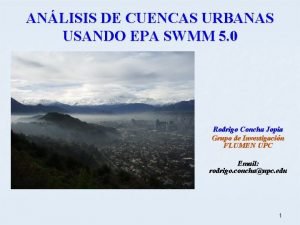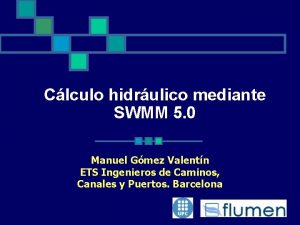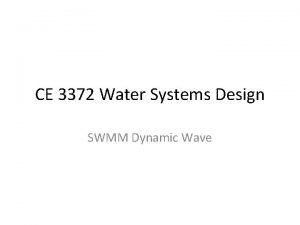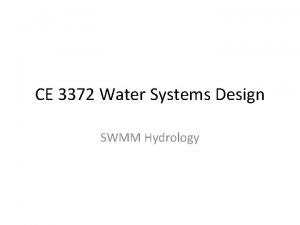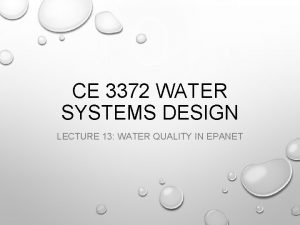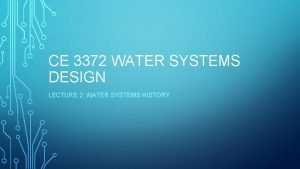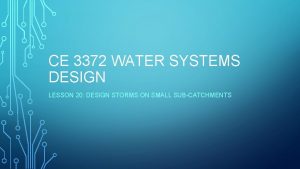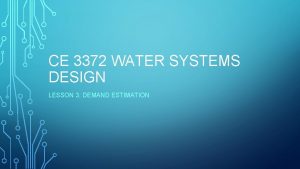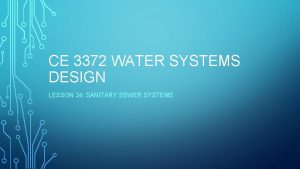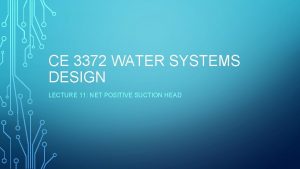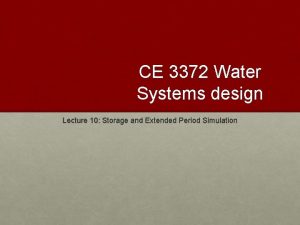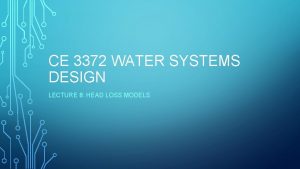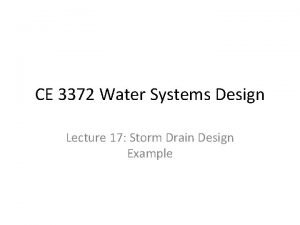CE 3372 Water Systems Design SWMM Dynamic Wave














- Slides: 14

CE 3372 Water Systems Design SWMM Dynamic Wave

Dynamic Wave • Used when: – Need to investigate backwater effects; gradually varied flow – Need to investigate looped systems – Need to approximate overland flow and inundation – Need to investigate time-varying flow

St. Venant Equations • Dynamic wave approximates solutions to coupled conservation of mass and momentum equations – Presented in next few slides without derivation

Definition Sketch of a Reach

Conservation of Mass Gain/Loss in the Depth Prism Lateral Inflow q Discharge across section faces

Momentum & Force Balance Computational Reach Length

Conservation of Momentum • Pressure-integral (to compute pressure forces) Forces on wall taper Forces on end faces

Conservation of Momentum • Linear Momentum Balance • Result of some calculus Net momentum entering cell Pressure force, end sections Pressure force, bank taper Gravitational force Friction force opposing flow Total acceleration in the cell

Coupled Equations • Continunity • Momentum Normal Gradually Varied Fully Dynamic, Shallow Wave

Dynamic Wave • Obviously complex because there are so many pieces – Need a program (some way to make all the calculations) • SWMM, HEC-RAS are the most common tools for these kinds of calculations

Dynamic Wave • Big differences are: – SWMM • uses explicit finite-difference formulation; fewer boundary condition restrictions at the cost of speed. • can do looped systems without much fuss • Integrated hydrology

Dynamic Wave • Big differences are: – HEC-RAS • uses implicit finite-difference formulation; more boundary condition restrictions, but faster. • Looped systems tricky • Does not do circular sections very well • River systems, culverts, bridges, etc. • Hydrology is independent (usually by HEC-HMS)

Dynamic Wave in SWMM • Change the routing method • SET BOUNDARY CONDITIONS • SET TIME WINDOW and STEP SIZE carefully • Usually have to add storage elements to have things work better

Examples in SWMM • TBD
 Proxyvo
Proxyvo Epa swmm descargar
Epa swmm descargar Swmm ejemplos
Swmm ejemplos Swmm
Swmm Water and water and water water
Water and water and water water Light is electromagnetic wave true or false
Light is electromagnetic wave true or false Long waves and short waves
Long waves and short waves Difference between full wave and half wave rectifier
Difference between full wave and half wave rectifier Transverse and longitudnal waves
Transverse and longitudnal waves Define half wave rectifier
Define half wave rectifier Fullwave rectification
Fullwave rectification P and s wave arrival time chart
P and s wave arrival time chart Rectified sine wave fourier series
Rectified sine wave fourier series Longitudinal wave
Longitudinal wave The wave chapter 10
The wave chapter 10

